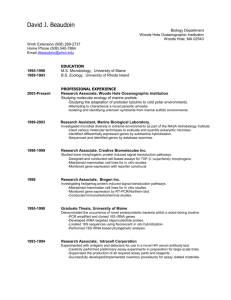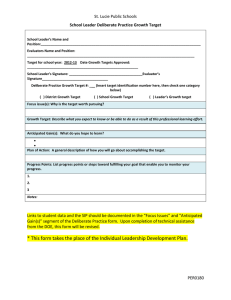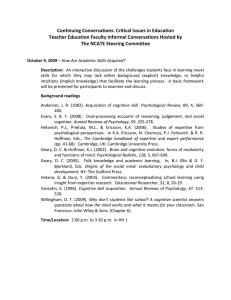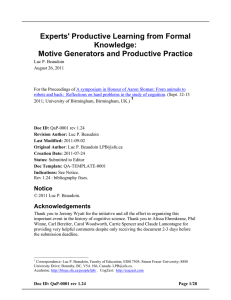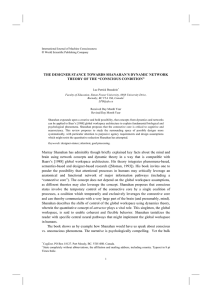Collaborative productive practice for professional and personal development
advertisement
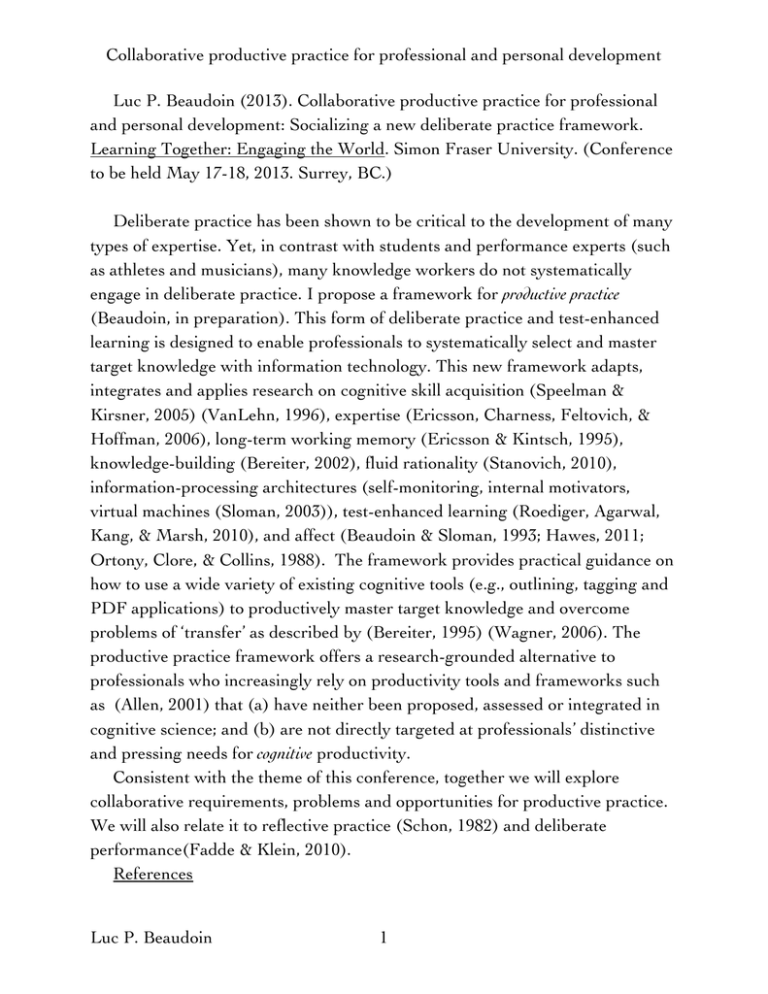
Collaborative productive practice for professional and personal development Luc P. Beaudoin (2013). Collaborative productive practice for professional and personal development: Socializing a new deliberate practice framework. Learning Together: Engaging the World. Simon Fraser University. (Conference to be held May 17-18, 2013. Surrey, BC.) Deliberate practice has been shown to be critical to the development of many types of expertise. Yet, in contrast with students and performance experts (such as athletes and musicians), many knowledge workers do not systematically engage in deliberate practice. I propose a framework for productive practice (Beaudoin, in preparation). This form of deliberate practice and test-enhanced learning is designed to enable professionals to systematically select and master target knowledge with information technology. This new framework adapts, integrates and applies research on cognitive skill acquisition (Speelman & Kirsner, 2005) (VanLehn, 1996), expertise (Ericsson, Charness, Feltovich, & Hoffman, 2006), long-term working memory (Ericsson & Kintsch, 1995), knowledge-building (Bereiter, 2002), fluid rationality (Stanovich, 2010), information-processing architectures (self-monitoring, internal motivators, virtual machines (Sloman, 2003)), test-enhanced learning (Roediger, Agarwal, Kang, & Marsh, 2010), and affect (Beaudoin & Sloman, 1993; Hawes, 2011; Ortony, Clore, & Collins, 1988). The framework provides practical guidance on how to use a wide variety of existing cognitive tools (e.g., outlining, tagging and PDF applications) to productively master target knowledge and overcome problems of ‘transfer’ as described by (Bereiter, 1995) (Wagner, 2006). The productive practice framework offers a research-grounded alternative to professionals who increasingly rely on productivity tools and frameworks such as (Allen, 2001) that (a) have neither been proposed, assessed or integrated in cognitive science; and (b) are not directly targeted at professionals’ distinctive and pressing needs for cognitive productivity. Consistent with the theme of this conference, together we will explore collaborative requirements, problems and opportunities for productive practice. We will also relate it to reflective practice (Schon, 1982) and deliberate performance(Fadde & Klein, 2010). References Luc P. Beaudoin 1 Collaborative productive practice for professional and personal development Allen, D. (2001). Getting things done: The art of stress-free productivity. New York, N.Y.: The Penguin Group. Beaudoin, L. P. (Manuscript in preparation). From information to excellence: Develop professionally and personally with cognitive science and technology. Beaudoin, L. P., & Sloman, A. (1993). A study of motive processing and attention. In A. Sloman, D. Hogg, G. Humphreys, D. Partridge, & A. Ramsay (Eds.), (pp. 229–238). Presented at the Prospects for Artificial Intelligence, Amsterdam: IOS Press. Bereiter, C. (1995). A dispositional view of transfer. In A. McKeough, J. Lupart, & A. Marini (Eds.), Teaching for Transfer: Fostering Generalization in Learning (pp. 21–34). Erlbaum. Bereiter, C. (2002). Education and mind in the knowledge age. Mahwah, NJ: Laurence Earlbaum Associates. Ericsson, K. A., Charness, N., Feltovich, P. J., & Hoffman, R. R. (2006). The Cambridge handbook of expertise and expert performance. Cambridge University Press. Ericsson, K., & Kintsch, W. (1995). Long-term working memory, 102(2), 211– 245. Fadde, P. J., & Klein, G. A. (2010). Deliberate performance: Accelerating expertise in natural settings. Performance Improvement, 49(9), 5–14. doi:10.1002/pfi Hawes, N. (2011). A survey of motivation frameworks for intelligent systems. Artificial Intelligence, 175(5-6), 1020–1036. Ortony, A., Clore, G. L., & Collins, A. (1988). The cognitive structure of emotions. Cambridge, MA: Cambridge University Press. Roediger, H. L., Agarwal, P. K., Kang, S. H. K., & Marsh, E. J. (2010). Benefits of testing memory: Best practices and boundary conditions. Psychology. Schon, D. A. (1982). The Reflective Practitioner. Basic Books. Sloman, A. (2003). How many separately evolved emotional beasties live within us? In R. Trappl, P. Petta, & S. Payr (Eds.), Emotions in Humans and Artifacts (pp. 35–114). MIT Press. Retrieved from http://cognet.mit.edu.proxy.lib.sfu.ca/library/books/view?isbn=0262201429 Speelman, C. P., & Kirsner, K. (2005). Beyond the learning curve: The construction of mind. New York, NY: Oxford University Press, USA. Stanovich, K. (2010). Rationality and the Reflective Mind (1st ed.). Oxford University Press, USA. VanLehn, K. (1996). Cognitive skill acquisition. Annual Review of Psychology, 47(1), 513–539. doi:10.1146/annurev.psych.47.1.513 Wagner, J. F. (2006). Transfer in Pieces. Cognition and Instruction, 24(1), 1–71. Luc P. Beaudoin 2 Collaborative productive practice for professional and personal development Luc P. Beaudoin 3
